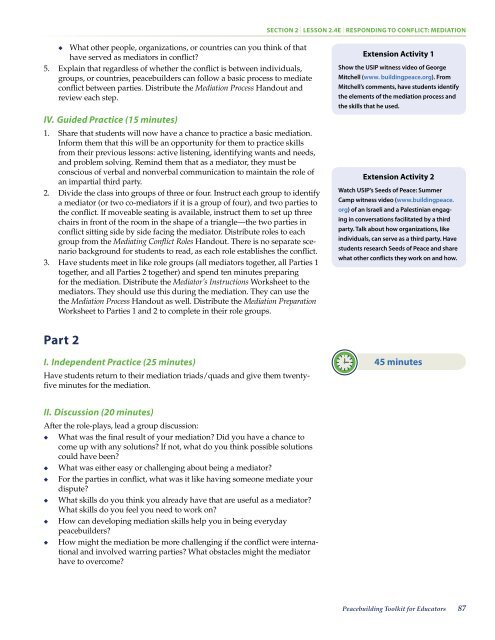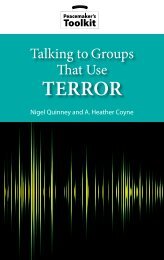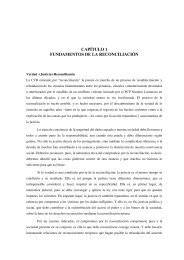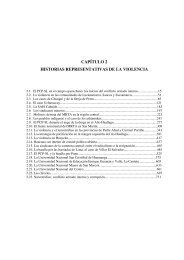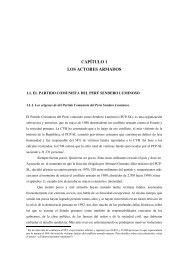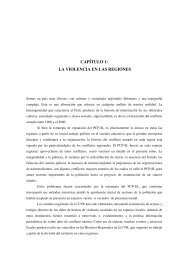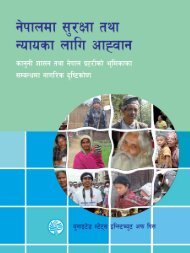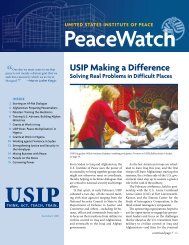Download PDF (5.43 MB) - ReliefWeb
Download PDF (5.43 MB) - ReliefWeb
Download PDF (5.43 MB) - ReliefWeb
Create successful ePaper yourself
Turn your PDF publications into a flip-book with our unique Google optimized e-Paper software.
SECTION 2 | Lesson 2.4E | responding to conflict: mediation◆◆ What other people, organizations, or countries can you think of thathave served as mediators in conflict?5. Explain that regardless of whether the conflict is between individuals,groups, or countries, peacebuilders can follow a basic process to mediateconflict between parties. Distribute the Mediation Process Handout andreview each step.IV. Guided Practice (15 minutes)1. Share that students will now have a chance to practice a basic mediation.Inform them that this will be an opportunity for them to practice skillsfrom their previous lessons: active listening, identifying wants and needs,and problem solving. Remind them that as a mediator, they must beconscious of verbal and nonverbal communication to maintain the role ofan impartial third party.2. Divide the class into groups of three or four. Instruct each group to identifya mediator (or two co-mediators if it is a group of four), and two parties tothe conflict. If moveable seating is available, instruct them to set up threechairs in front of the room in the shape of a triangle—the two parties inconflict sitting side by side facing the mediator. Distribute roles to eachgroup from the Mediating Conflict Roles Handout. There is no separate scenariobackground for students to read, as each role establishes the conflict.3. Have students meet in like role groups (all mediators together, all Parties 1together, and all Parties 2 together) and spend ten minutes preparingfor the mediation. Distribute the Mediator’s Instructions Worksheet to themediators. They should use this during the mediation. They can use thethe Mediation Process Handout as well. Distribute the Mediation PreparationWorksheet to Parties 1 and 2 to complete in their role groups.Extension Activity 1Show the USIP witness video of GeorgeMitchell (www. buildingpeace.org). FromMitchell’s comments, have students identifythe elements of the mediation process andthe skills that he used.Extension Activity 2Watch USIP’s Seeds of Peace: SummerCamp witness video (www.buildingpeace.org) of an Israeli and a Palestinian engagingin conversations facilitated by a thirdparty. Talk about how organizations, likeindividuals, can serve as a third party. Havestudents research Seeds of Peace and sharewhat other conflicts they work on and how.Part 2I. Independent Practice (25 minutes)Have students return to their mediation triads/quads and give them twentyfiveminutes for the mediation.45 minutesII. Discussion (20 minutes)After the role-plays, lead a group discussion:◆◆ What was the final result of your mediation? Did you have a chance tocome up with any solutions? If not, what do you think possible solutionscould have been?◆◆ What was either easy or challenging about being a mediator?◆◆ For the parties in conflict, what was it like having someone mediate yourdispute?◆◆ What skills do you think you already have that are useful as a mediator?What skills do you feel you need to work on?◆◆ How can developing mediation skills help you in being everydaypeacebuilders?◆◆ How might the mediation be more challenging if the conflict were internationaland involved warring parties? What obstacles might the mediatorhave to overcome?Peacebuilding Toolkit for Educators87


